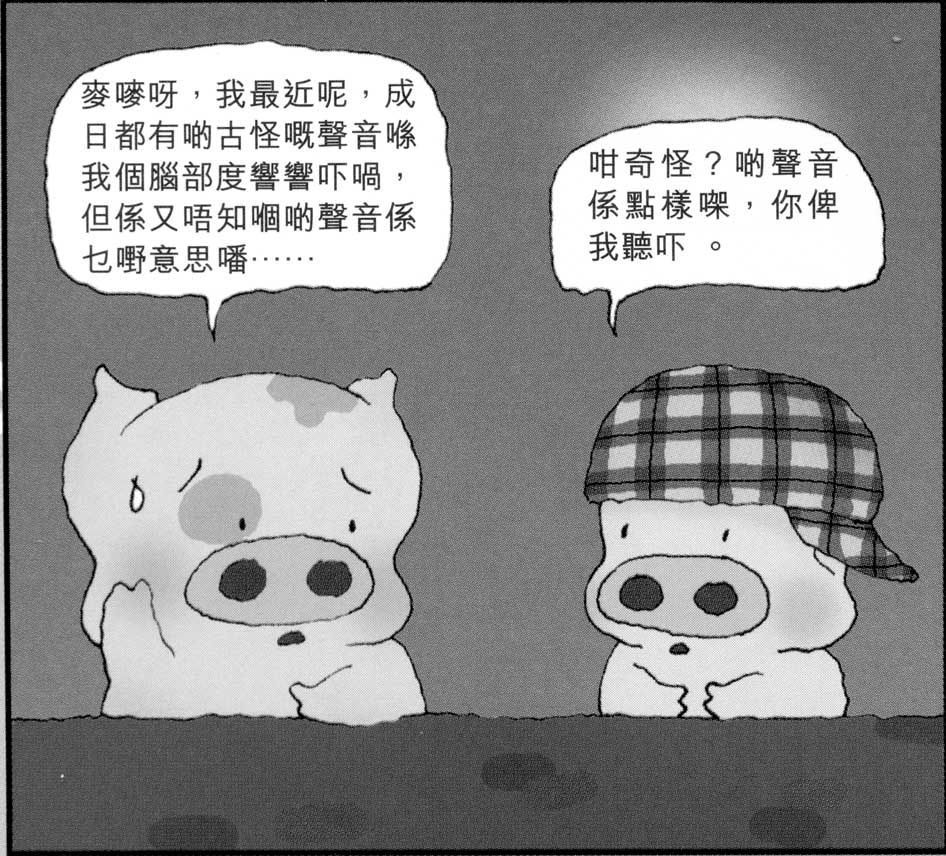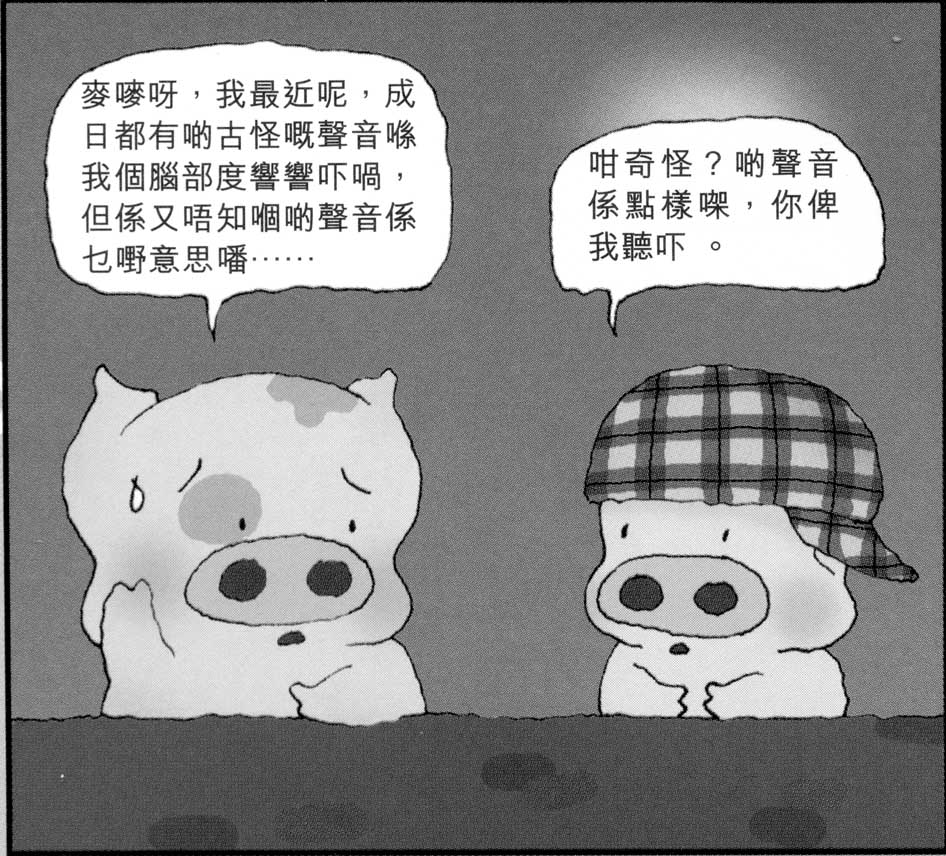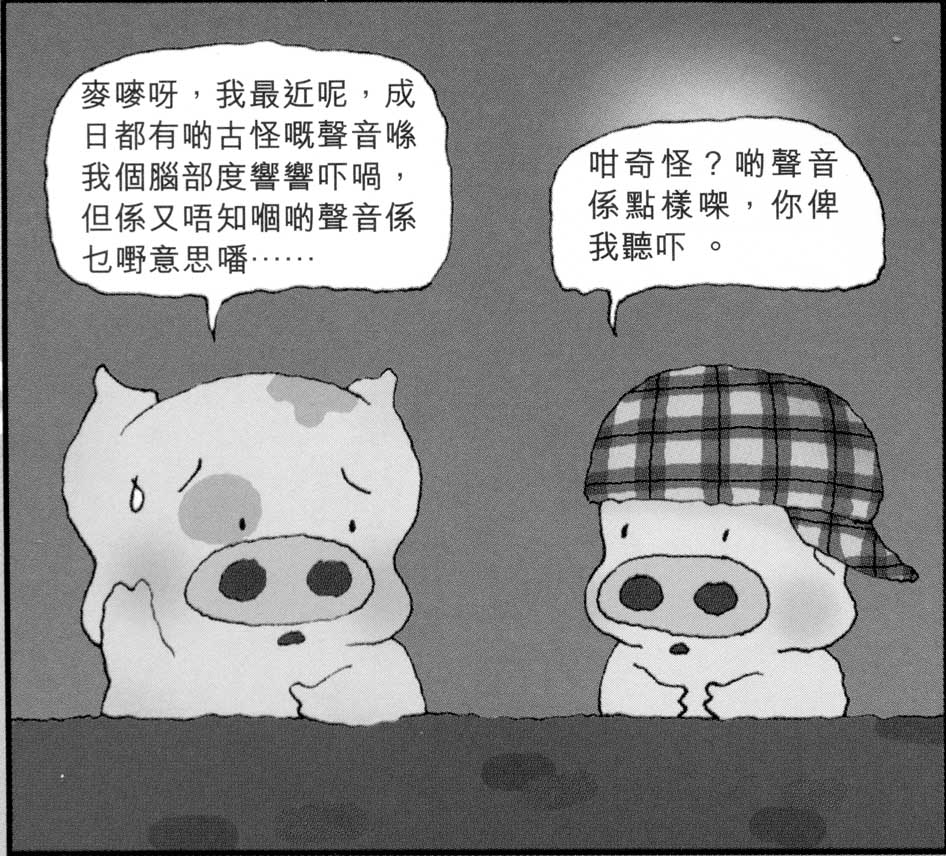
I know! How about a thread on Written Cantonese? Yes, it’s the written language that is widely used by millions of people but largely invisible outside its community of users!
2/
2/

My first visit to Hong Kong, as a young American with three years of college-level Chinese language study under my belt, was a bit of a shock. Nobody had prepared me for the reality of Written Cantonese. I didn’t know it existed.
(I love Hong Kong, by the way.)
3/
(I love Hong Kong, by the way.)
3/

I was familiar with the oft-repeated maxim that “The Chinese dialects are spoken differently but all are written the same.”
And I even knew that it was at best half-true, because Modern Standard Written Chinese is in fact a written form of spoken Mandarin.
4/
And I even knew that it was at best half-true, because Modern Standard Written Chinese is in fact a written form of spoken Mandarin.
4/
I didn’t expect that I would understand Cantonese speakers, but I assumed that I’d be able to make my way effectively around the city because of my knowledge of Chinese characters and Chinese writing. (Because Standard Written Chinese is Standard Written Chinese everywhere.)
5/
5/
And that proved to be true in a lot of situations. But I remember a feeling of shock and vertigo my first few days in the city, seeing all around me unfamiliar characters and undecipherable signs—especially advertisements.
6/
6/
Here’s a contemporary example of the kind of ad that I was seeing everywhere in Hong Kong: on the sides of buses, on the walls of underground metro stations, on posters in a shop window.
#香港真係好靚
What does that say?
7/
#香港真係好靚
What does that say?
7/

(On the controversy surrounding this series of ads for Watsons water featuring lovely images by photographer Kelvin Yuen, see
hongkongfp.com/2021/06/21/hon… .)
8/
hongkongfp.com/2021/06/21/hon… .)
8/
How did I react?
A diligent student of foreign languages, I scribbled down the characters or took photos.
(This was long before the internet or smartphones. I took photos with a camera. I scribbled with a pencil in a notebook.)
9/
A diligent student of foreign languages, I scribbled down the characters or took photos.
(This was long before the internet or smartphones. I took photos with a camera. I scribbled with a pencil in a notebook.)
9/
But many of those characters weren’t to be found anywhere in my trusty paper dictionaries.
What was going on here?
10/
What was going on here?
10/
After a while I learned what was really going on. It wasn’t just that spoken Cantonese was a distinct language from spoken Mandarin. They are not mutually intelligible— not just because of pronunciation, but because of differences in vocabulary, morphology, and syntax.
11/
11/
They are obviously similar, true, but only about as similar as French is to Spanish. The term “dialect” is an unfortunate misnomer, and when understood with its meaning as a technical term in the field of linguistics it is completely inappropriate. Cantonese is a language.
12/
12/
But it wasn’t just that I had encountered a different spoken language. It was something I hadn’t known before: spoken Cantonese could be written down. And Written Cantonese therefore differed from Standard Written Chinese in vocabulary, morphology, and syntax.
13/
13/
Formal writing, taught in schools and used in newspapers, essays, government documents, and so on, was Modern Standard Written Chinese. It was in a way a second language to its users.
14/
14/
Little kids growing up in Hong Kong and Guangzhou couldn’t just write down the sentences in their heads. They had to express those ideas with different words and different syntactic structures.
15/
15/
An example: To express ‘Where is she now?’, a Cantonese speaker might say
“Keoi5 ji4gaa1 hai2 bin1dou6 aa3?”
16/
“Keoi5 ji4gaa1 hai2 bin1dou6 aa3?”
16/
If asked to write down a sentence meaning “Where is she now?” in a formal context, that same Cantonese speaker would write:
他現在在哪裏?
17/
他現在在哪裏?
17/
If you then delivered that written sentence to another Cantonese speaker and asked them to read it out loud, you would hear:
“Taa1 jin6zoi6 zoi6 naa5leoi5?”
18/
“Taa1 jin6zoi6 zoi6 naa5leoi5?”
18/
From “Keoi5 ji4gaa1 hai2 bin1dou6 aa3?”
to “Taa1 jin6zoi6 zoi6 naa5leoi5?” —
they don’t sound anything alike, do they?
19/
to “Taa1 jin6zoi6 zoi6 naa5leoi5?” —
they don’t sound anything alike, do they?
19/
It’s because the written sentence isn’t in Cantonese. Sure, the reading pronunciations of the characters are in Cantonese, but this isn’t something Cantonese speakers would ever say in normal conversation. It's a Mandarin sentence disguised in a cloak of Cantonese phonology.
20/
20/
This kind of diglossia in itself isn’t so unusual. A large portion of the human population writes in a language significantly distinct from their spoken tongue. Swiss Germans write High German. Speakers of various regional Arabics write in Modern Standard Arabic.
21/
21/
Standard Written Chinese is taught and learned so early in schools in Cantonese-speaking regions, and is used so commonly in all aspects of daily life, that it doesn’t feel foreign. It’s just a different register of expression.
22/
22/
But none of that explained the questions I had about *Written Cantonese*. What was it doing all around me? When was it used? Who invented it? How did people learn it? And … why?
And ... could I learn it?
23/
And ... could I learn it?
23/
And it turns out that nobody invented it, nobody standardized it, and nobody taught it (at least, not until recently.) It all developed more or less organically.
24/
24/
By virtue of being native speakers of Cantonese, and knowing the meanings and pronunciations of the characters as used in Standard Written Chinese, Cantonese speakers could puzzle out Written Cantonese rather effortlessly, even on first exposure.
25/
25/
They learn its conventions from observing the community of users around them without needing any formal training. A written sentence like this—“佢而家喺邊喥呀?”—is easily understood to write that spoken Cantonese sentence meaning ‘Where is she now?’.
26/
26/
“佢而家喺邊喥呀?” is a direct written representation of “Keoi5 ji4gaa1 hai2 bin1dou6 aa3?“.
Unlike “他現在在哪裡?“ which is a *translation* of the sentence into Mandarin.
27/
Unlike “他現在在哪裡?“ which is a *translation* of the sentence into Mandarin.
27/
So how do Cantonese speakers learn to read Written Cantonese without being formally taught?
I’ve written about this before, in the context of the adaptation of Chinese characters to writing non-Chinese languages:
28/
I’ve written about this before, in the context of the adaptation of Chinese characters to writing non-Chinese languages:
28/
Humans are really really good at isolating either the conventional meaning or the conventional pronunciation of Chinese characters, and then repurposing those same characters to write words in another language.
29/
29/
And speakers of that other language are really really good at puzzling out the intended meaning, even without training or explanation, because they share the same knowledge base as the writers.
30/
30/
So how does Cantonese writing work? Let’s explore it starting with this panel from the delightful McMug (麥嘜 Mak6 Mak1) family of cartoons by Bliss. The main characters are a pair of kindergarten-age pigs growing up in Hong Kong.
31/
31/

(As you'll discover, this whole description is very much from the perspective of an American native English speaker who first approached Written Cantonese from the perspective of knowing Mandarin.
Your mileage may vary. Caveat emptor.)
32/
Your mileage may vary. Caveat emptor.)
32/
If you know Standard Written Chinese, you can probably muddle your way through this and understand the gist of it. But there are a bunch of words you won’t be able to say out loud, and you might be a bit fuzzy on some of the words. You’ll never get the precise meaning.
33/
33/
To fully understand it, you have to do more even than recognize all the characters. You have to understand the words and the grammar—which means you have to know spoken Cantonese. Having proficiency in spoken Cantonese is a prerequisite to reading written Cantonese.
34/
34/
So here are the basic rules for how the Chinese script has been adapted to write spoken Cantonese. There are only two.
Well, three, because Rule 2 has two parts.
Well, four, because there are some characters that don't fit the three rules.
But let's just say two rules.
35/
Well, three, because Rule 2 has two parts.
Well, four, because there are some characters that don't fit the three rules.
But let's just say two rules.
35/
Rule 1) Any word of Cantonese that is recognizably cognate to words in the mainstream written tradition (Classical Chinese or Modern Standard Chinese) is written with the same character, regardless of differences in pronunciation between Cantonese and Mandarin.
36/
36/
There are lot of words like this, because Cantonese and Mandarin (like Spanish and French) share a lot of cognates. These are your friends if you know Mandarin: they are the written Cantonese words that present no problem to any literate reader of Chinese.
37/
37/
Some of these are hard for a Mandarin speaker to recognize when spoken aloud in Cantonese, but they present no problem in written form.
Compare the pronunciations:
我 ngo5 | wǒ
最近 zeoi3gan6 | zuìjìn
聲音 sing1jam1 | shēngyīn
意思 ji3si3 | yìsi
聽 ting1 | tīng
39/
Compare the pronunciations:
我 ngo5 | wǒ
最近 zeoi3gan6 | zuìjìn
聲音 sing1jam1 | shēngyīn
意思 ji3si3 | yìsi
聽 ting1 | tīng
39/
Rule 2) Nearly all words that are not obviously cognate are written in one of two ways:
a) Sound borrowing
b) Sound borrowing with an added “radical”, typically 口 [MOUTH]
Many of these non-cognate words are grammatical function words and sentence-final modals.
40/
a) Sound borrowing
b) Sound borrowing with an added “radical”, typically 口 [MOUTH]
Many of these non-cognate words are grammatical function words and sentence-final modals.
40/
We have seen already an example of 2a: writing the word ji4gaa1 ‘now’ with the two characters 而家, based on the characters' Cantonese pronunciations ji4 and gaa1. The Cantonese word is equivalent in meaning to Mandarin xiànzài 現在.
41/
41/
[Some of you may recognize this word from my confounding quiz on compound characters.
42/
https://twitter.com/ZevHandel/status/1400706941119189003]
42/
Here are some examples of Rule 2 adaptations:
度 dou6 location suffix: from sound of dou6 度 ‘degree’ (can also be written 喥)
喺 hai2 ‘to be at’: from 口 [MOUTH] + sound of hai6 係 ‘to be’
咁 gam2 ‘so, in such a way’: from 口 [MOUTH] + sound of gam1 甘 ‘sweet’
43/
度 dou6 location suffix: from sound of dou6 度 ‘degree’ (can also be written 喥)
喺 hai2 ‘to be at’: from 口 [MOUTH] + sound of hai6 係 ‘to be’
咁 gam2 ‘so, in such a way’: from 口 [MOUTH] + sound of gam1 甘 ‘sweet’
43/

And here are some differences in vocabulary between Cantonese and Mandarin (i.e. non-cognate words) that are also important to understanding the meaning of the cartoon:
44/
44/
hai2 喺 ‘to be at’ (equivalent to M. zài 在)
bei2 俾 ‘give’ (equivalent to M. gěi 給)
m4 唔 ‘not’ (equivalent to M. bù 不)
hai6 係 ‘is’ (equivalent to M. shì 是)
di1 啲 ‘some’ (equivalent to M. xiē 些)
45/
bei2 俾 ‘give’ (equivalent to M. gěi 給)
m4 唔 ‘not’ (equivalent to M. bù 不)
hai6 係 ‘is’ (equivalent to M. shì 是)
di1 啲 ‘some’ (equivalent to M. xiē 些)
45/

And of course there also differences in grammar—morphology and syntax. For example, zi1 知 ‘to know’ is a free morpheme in Cantonese, so by itself it constitutes the word ‘to know’. In Mandarin, zhī 知 is bound, so must be compounded to form a word, e.g. zhīdao 知道.
46/
46/
Another grammatical difference is that in Cantonese, measure words can be used bare with nouns, without a number or demonstrative before them. This usage conveys definiteness in a way more or less similar to that imparted by the English article ‘the’.
47/
47/
In Mandarin, McMug’s second sentence would have to start with 那 ‘that’ to be grammatical: Nà xiē shēngyīn 那些聲音 ‘those sounds …’, because you can’t say *些聲音 ‘the sounds’.
48/
48/
But in Cantonese, it’s fine for a bare measure word to occur at the start of the noun phrase: di1 sing1jam1 啲聲音 ‘the sounds …’.
49/
49/
Okay, enough grammar. Back to the cartoon.
That’s McDull (Mak6 Dau1 麥兜) on the left, the dumb one who is always sweating in consternation. And there on the right is McMug, the smart, patient, sympathetic one, wearing the cap.
50/
That’s McDull (Mak6 Dau1 麥兜) on the left, the dumb one who is always sweating in consternation. And there on the right is McMug, the smart, patient, sympathetic one, wearing the cap.
50/

Here’s a translation (PLEASE correct any mistakes):
McDull: McMug, recently I’ve had some strange sounds constantly echoing inside my head, but I don’t even know what those sounds mean …
McMug: Strange in what way? Let me hear what the strange sounds are like.
51/
McDull: McMug, recently I’ve had some strange sounds constantly echoing inside my head, but I don’t even know what those sounds mean …
McMug: Strange in what way? Let me hear what the strange sounds are like.
51/
Here’s an earlier McMug cartoon. The drawing style is cruder and the characterization hasn’t quite settled. I love how McMug thinks in Cantonese but writes to his pen-pal in Standard Chinese. It perfectly captures the sociolinguistic functions of the two written languages.
52/
52/

So is there a point to this thread? I mean, aside from the obvious fact that Cantonese writing is cool and fun?
Hmm. Let’s see. 🤔 I can think of a few. 🧐
53/
Hmm. Let’s see. 🤔 I can think of a few. 🧐
53/
1) Educated, literate speakers of any Chinese language have learned how to read and write Standard Written Chinese, which is based on spoken Mandarin.
But that’s not the same as a written form of their spoken language.
54/
But that’s not the same as a written form of their spoken language.
54/
2) Cantonese has a well-developed written language. It’s not formally taught, but because it relies on universal principles of script adaptation, native speakers pick it up easily. I’ve talked about these universals before (see #2, #5, and #24 here:
55/
https://twitter.com/ZevHandel/status/1375674539305172992)
55/
3) Any Chinese language can be written, and many have been. There are many choices for how to do that. There are other ways to potentially write Cantonese, including Jyutping romanization and the split-syllabic spelling system known as 粵切字 zh-yue.wikipedia.org/wiki/%E7%B2%B5…
56/
56/
4) The way the Chinese script had been adapted to write Cantonese isn’t so different from the way it’s been adapted to write Korean, Japanese, Vietnamese, and other languages throughout history.
57/
57/
The fact that Cantonese and Mandarin share so many cognates and so many grammatical features can superficially obscure that larger connection to the history of Chinese script adaptation. But it’s there.
58/
58/
5) I’ll plug here my book Sinography, which is all about describing these adaptation processes and the reasons why they recur over and over again throughout history.
(And: It’s refreshingly inexpensive for a Brill publication.) brill.com/view/title/392…
59/
(And: It’s refreshingly inexpensive for a Brill publication.) brill.com/view/title/392…
59/
Thanks for the correction.
https://twitter.com/havingfunnot/status/1414831633924956160
I'm appending some corrections. Thank you to @15israel and others who helpfully pointed out some errors.
@15Israel 1) The image in the first tweet has an incorrect tone number, at least if it is supposed to be Jyutping notation. I didn’t make the image so don't know the intention. The correct Jyutping romanization of 唔該 is m4goi1 (m 唔 is Tone 4).
https://twitter.com/ZevHandel/status/1414796995290570764
@15Israel 2) As a word by itself, as seen in the cartoon, 聽
is pronounced teng1, not ting1. (It is pronounced ting1 in some compounds.)
is pronounced teng1, not ting1. (It is pronounced ting1 in some compounds.)
https://twitter.com/ZevHandel/status/1414810542057816076
Regarding 意思 also seen in that list of words in the same tweet, @deryckchan and @havingfunnot point out that it is more likely to be pronounced ji3si1 than ji3si3, though there may be some variation across speakers.
https://twitter.com/havingfunnot/status/1414831633924956160
3) 咁 as used in this cartoon writes gam3 ‘so, to such an extent’. The same character is also used to write gam2 ‘in such a way, thus’ and in that sense is interchangeable with 噉. Variation in written forms is typical of non-standardized writing systems.
https://twitter.com/ZevHandel/status/1414812767513546753
As a foreign student of Cantonese, I find the distinction between gam2 and gam3 hard to master, especially as they are written identically, and both correspond to different senses of the English word 'so'.
I appreciate the chance to correct these errors.
I appreciate the chance to correct these errors.
• • •
Missing some Tweet in this thread? You can try to
force a refresh











